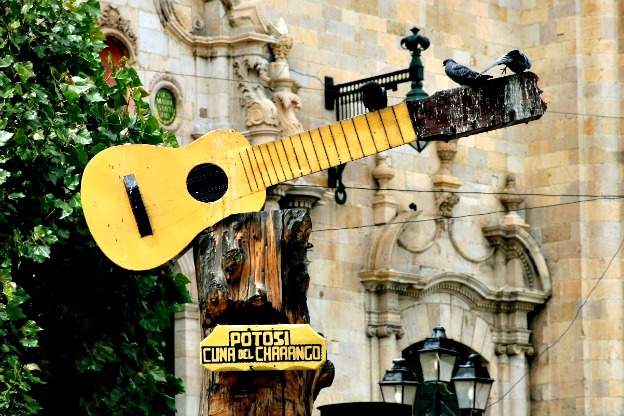
Time capsule for this episode: Cathedral in Bogotá, Columbia.
Hidalgo and Herrera at Bogotá Cathedral
Gutierre Fernándo Hidalgo was born around 1547 in Spain and worked in the sophisticated musical establishment of Salamanca and its environs until his departure for South America in 1583. Shortly after being appointed maestro di capilla of what is now Columbia's Cathedral of Bogotá, Hidalgo obtained an order from the Bishop that required the young seminarians to sing in the cathedral every day. Unfortunately this created a serious scandal. Hidalgo probably had very demanding musical standards because on January 20, 1585 the entire student body fled, and the maestro was replaced by one of his students. Between then and his death, Hidalgo held positions as both priest and maestro di capilla in Quito, Lima, Cuzco and La Plata.
Alas, a good bit of his music seems to have been lost, and what there is survives only in manuscript.
The composer Juan de Herrera spent his whole life in Bogotá. Not only maestro di capilla at the Cathedral for five years, he was also chaplain and choirmaster to the nuns of the Dominican Convent St. Inés for more than 40 years. In an interesting contrast to Hidalgo, the chapter of the Cathedral tried to replace Herrera because he was too permissive toward the musicians, but he was reinstated when the musicians protested.
A prolific and skilled composer, Herrera wrote sophisticated polychoral liturgical music, but also villancicos, vernacular songs with verses framed by a refrain. Let's hear a villancico and a mass movement of Herrera.
Latin American baroque ensemble, Musica Temprana
The ensemble Musica Temprana was formed in 2001 to explore Latin American baroque music. Their director, Adrián RodrÃguez Van der Spoel, spent the first 26 years of his life in Argentina, then moved to The Netherlands. He is a choir conductor who has also studied composition as well as traditional, folk, and early music; he plays several instruments and researches Latin American music.
In Van der Spoel's own words, "…Our repertoire needs a profound knowledge of the rich folk music tradition of Latin America, and a clear insight into the character, temperament, thinking and uniqueness of the continent in general."
(Check out the bottom of this episode's "complete playlist" for all the Musica Temprana pieces heard.)
Musica Temprana has performed extensively in The Netherlands and has also traveled to Bolivia, Peru, Costa Rica, Japan, Norway and the Czech Republic.
The ensemble combines what have become traditional performance practices for European baroque music with threads of Creole, Indian, and African influences that contribute to the cultural diversity of Latin America. Their instrumentarium includes a variety of Latin-American instruments such as bombo legüero, charango and percussion, alongside the harp, violin, guitar, organ and harpsichord.
From saraband to Sarabande
Early music enthusiasts will recognize the Sarabande as a standard movement of the Baroque suite, along with the Allemande, Courante, and Gigue. For example, here's JS Bach's Sarabande from his first cello suite, performed on the lute by Nigel North.
Though nowadays usually thought of as stately and serious, the saraband, first mentioned in a poem from Panama in 1539, was originally a wild and energetic sung dance. Accompanied by guitar, castanets and possibly other percussion, the zarabanda, to use its Spanish name, was considered so lewd that it was actually banned in Spain in 1583! The dance arrived in Italy in the early 17th century along with the Spanish 5-course guitar. Here's a late 17th-century zarabanda by the Spanish priest and guitarist Gaspar Sanz.
Another spritely saraband, often with two repeated sections, appears as the final movement of dance suites in 17th century England, as in this example by Matthew Locke.
At the same time in mid- to late-17th century France and Germany, a very different kind of saraband developed as a slow triple dance, frequently with a repeat of the final four bars, as in this Sarabande of Marin Marais.
What a journey the sarabande had from its wild, obscene origins to the favored movement of JS Bach for virtuoso solo instrument settings, and even though it is not labeled as a dance, the final chorus of the St. Matthew Passion.
Featured recording: Los Ministriles in the New World
Our featured release, Piffaro's 2012 recording Los Ministriles in the New World is a musical meeting of two cultures.
Sometimes, a single composer can embody both the "new" and the "old," as is the case of Portuguese-born Gaspar Fernandes who made the  journey from across the Atlantic to live and work in colonial Guatemala and Mexico. Like other Spanish musicians and composers heard on this recording, he not only spread Old World musical culture but also assimilated sounds of indigenous and African influence from the New World. On this recording, we'll hear recorders, plucked strings, shawms, dulcians, sackbuts, bagpipes and castanets in music originating from both the Iberian Peninsula and the Americas.









